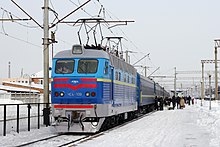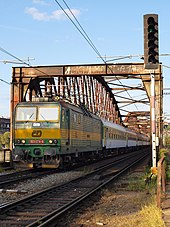
Back Elektriese lokomotief Afrikaans Elektrolokomotive ALS القطر الكهربائى ARZ Электравоз Byelorussian Електрически локомотив Bulgarian इलेक्ट्रिक रेलइंजन Bihari Tren elèctric Catalan Elektrická lokomotiva Czech Ellokomotiv Danish Elektrolokomotive German




An electric locomotive is a locomotive powered by electricity from overhead lines, a third rail or on-board energy storage such as a battery or a supercapacitor. Locomotives with on-board fuelled prime movers, such as diesel engines or gas turbines, are classed as diesel–electric or gas turbine–electric and not as electric locomotives, because the electric generator/motor combination serves only as a power transmission system.
Electric locomotives benefit from the high efficiency of electric motors, often above 90% (not including the inefficiency of generating the electricity). Additional efficiency can be gained from regenerative braking, which allows kinetic energy to be recovered during braking to put power back on the line. Newer electric locomotives use AC motor-inverter drive systems that provide for regenerative braking. Electric locomotives are quiet compared to diesel locomotives since there is no engine and exhaust noise and less mechanical noise. The lack of reciprocating parts means electric locomotives are easier on the track, reducing track maintenance. Power plant capacity is far greater than any individual locomotive uses, so electric locomotives can have a higher power output than diesel locomotives and they can produce even higher short-term surge power for fast acceleration. Electric locomotives are ideal for commuter rail service with frequent stops. Electric locomotives are used on freight routes with consistently high traffic volumes, or in areas with advanced rail networks. Power plants, even if they burn fossil fuels, are far cleaner than mobile sources such as locomotive engines. The power can also come from low-carbon or renewable sources, including geothermal power, hydroelectric power, biomass, solar power, nuclear power and wind turbines.[1] Electric locomotives usually cost 20% less than diesel locomotives, their maintenance costs are 25–35% lower, and cost up to 50% less to run.[2]
The chief disadvantage of electrification is the high cost for infrastructure: overhead lines or third rail, substations, and control systems. The impact of this varies depending on local laws and regulations. For example, public policy in the U.S. interferes with electrification: higher property taxes are imposed on privately owned rail facilities if they are electrified.[citation needed] The EPA regulates exhaust emissions on locomotive and marine engines, similar to regulations on car & freight truck emissions, in order to limit the amount of carbon monoxide, unburnt hydrocarbons, nitric oxides, and soot output from these mobile power sources.[3] Because railroad infrastructure is privately owned in the U.S., railroads are unwilling to make the necessary investments for electrification. In Europe and elsewhere, railway networks are considered part of the national transport infrastructure, just like roads, highways and waterways, so are often financed by the state.[citation needed] Operators of the rolling stock pay fees according to rail use. This makes possible the large investments required for the technically and, in the long-term, also economically advantageous electrification.
- ^ Hay, William W (1982). "The economics of electrification". Railroad engineering. Vol. 1. New York: Wiley. p. 137. ISBN 978-0-471-36400-9.
- ^ "Electrification of U.S. Railways: Pie in the Sky, or Realistic Goal? | Article | EESI".
- ^ "EPA, Transportation and Air Quality". 16 August 2016.